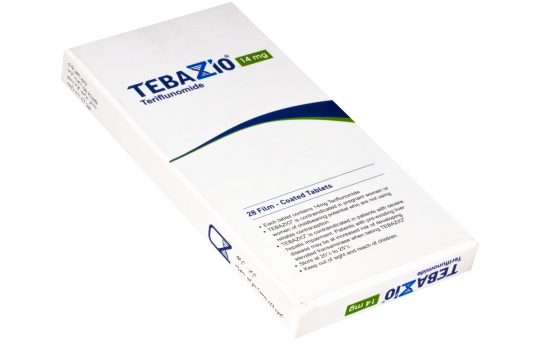1- What is Tebazio?
Tebazio® is indicated for the treatment of relapsing forms of multiple sclerosis (MS), to include clinically isolated syndrome (CIS), relapsing-remitting disease, and active secondary progressive disease, in adults.
2- Dosage and Administration
The recommended dose of Tebazio is one 14 mg tablet per day.
- Drug Overdose:
There is no experience regarding teriflunomide overdose or intoxication in humans.
Teriflunomide 70 mg daily up to 14 days was well tolerated by healthy subjects.
In the event of clinically significant overdose or toxicity, cholestyramine or activated charcoal is recommended to accelerate elimination.
- Missed Dose:
In case you forget taking one dose, never take two tablets for the next dose and take your next dose as scheduled.
3- Dosage Form and Strength
Tebazio is available as film-coated (FC) tablets containing 14 mg of teriflunomide colored matt or pale blue. Tebazio is a pentagonal tablet with dose strength 14 imprinted on one side and engraved with the English letter Z on other side.
4- Tips before taking Tebazio
- Obtain transaminase and bilirubin levels within 6 months before initiation of Tebazio therapy. Monitor ALT levels at least monthly for six months after starting Tebazio.
- Obtain a complete blood cell count (CBC) within 6 months before the initiation of treatment with Tebazio. Further monitoring should be based on signs and symptoms of infection.
- Prior to initiating Tebazio, screen patients for latent tuberculosis infection with a tuberculin skin test or blood test for mycobacterium tuberculosis infection.
- Exclude pregnancy prior to initiation of treatment with Tebazio in females of reproductive potential.
• Check blood pressure before start of Tebazio treatment and periodically thereafter
5- Warnings and Precautions
- Hepatotoxicity:
Patients with pre-existing liver disease and patients taking other hepatotoxic drugs may be at increased risk for developing liver injury when taking Tebazio. Clinically significant liver injury can occur at any time during treatment with Tebazio. Patients with pre-existing acute or chronic liver disease, or those with serum alanine aminotransferase (ALT) greater than two times the upper limit of normal (ULN) before initiating treatment, should not normally be treated with Tebazio. Tebazio is contraindicated in patients with severe hepatic impairment.
Tebazio-induced liver injury in this patient could not be ruled out. Obtain serum transaminase and bilirubin levels within 6 months before initiation of Tebazio therapy. Monitor ALT levels at least monthly for six months after starting Tebazio. Consider additional monitoring when Tebazio is given with other potentially hepatotoxic drugs. Consider discontinuing Tebazio if serum transaminase increase (greater than three times the ULN) is confirmed. Monitor serum transaminase and bilirubin on Tebazio therapy, particularly in patients who develop symptoms suggestive of hepatic dysfunction, such as unexplained nausea, vomiting, abdominal pain, fatigue, anorexia, or jaundice and/or dark urine. If liver injury is suspected to be Tebazio-induced, discontinue Tebazio and start an accelerated elimination procedure and monitor liver tests weekly until normalized. If Tebazio-induced liver injury is unlikely because some other probable cause has been found, resumption of Tebazio therapy may be considered.
- Embryofetal Toxicity:
Tebazio may cause fetal harm when administered to a pregnant woman. Teratogenicity and embryofetal lethality occurred in animal reproduction studies in multiple animal species at plasma teriflunomide exposures similar to or lower than that in humans at the maximum recommended human dose (MRHD) of 14 mg/day. Tebazio is contraindicated for use in pregnant women and in females of reproductive potential not using effective contraception. Exclude pregnancy before starting treatment with Tbeazio in females of reproductive potential. Advise females of reproductive potential to use effective contraception during Tebazio treatment and during an accelerated drug elimination procedure after Tebazio treatment. If a woman becomes pregnant while taking Tebazio, stop treatment with Tebazio, apprise the patient of the potential risk to a fetus, and perform an accelerated drug elimination procedure to achieve a plasma teriflunomide concentration of less than 0.02 mg/L. Upon discontinuing Tebazio, it is recommended that all females of reproductive potential undergo an accelerated drug elimination procedure. Women receiving Tebazio treatment who wish to become pregnant must discontinue Tebazio and undergo an accelerated drug elimination procedure, which includes verification that plasma concentrations of teriflunomide are less than 0.02 mg/L (0.02 mcg/mL). Men wishing to father a child should also discontinue use of Tebazio and either undergo an accelerated elimination procedure or wait until verification that the plasma teriflunomide concentration is less than 0.02 mg/L (0.02 mcg/mL). Based on animal data, human plasma concentrations of teriflunomide of less than 0.02 mg/L (0.02 mcg/mL) are expected to have minimal embryofetal risk.
- Procedure for Accelerated Elimination of Teriflunomide:
Teriflunomide is eliminated slowly from the plasma. Without an accelerated elimination procedure, it takes on average 8 months to reach plasma concentrations less than 0.02 mg/L, although because of individual variations in drug clearance it may take as long as 2 years. An accelerated elimination procedure could be used at any time after discontinuation of Tebazio. Elimination can be accelerated by either of the following procedures:
- Administration of cholestyramine 8 g every 8 hours for 11 days. If cholestyramine 8 g three times a day is not well tolerated, cholestyramine 4 g three times a day can be used.
- Administration of 50 g oral activated charcoal powder every 12 hours for 11 days.
If either elimination procedure is poorly tolerated, treatment days do not need to be consecutive unless there is a need to lower teriflunomide plasma concentration rapidly. At the end of 11 days, both regimens successfully accelerated teriflunomide elimination, leading to more than 98% decrease in teriflunomide plasma concentrations. Use of the accelerated elimination procedure may potentially result in return of disease activity if the patient had been responding to Tebazio treatment.
- Bone Marrow Effects/Immunosuppression Potential/Infections:
- Bone Marrow Effects:
The decrease in mean WBC count occurred during the first 6 weeks and WBC count remained low during treatment. No cases of serious pancytopenia were reported in premarketing clinical trials of teriflunomide but rare cases of pancytopenia and agranulocytosis have been reported in the postmarketing setting with leflunomide. A similar risk would be expected for Tebazio. Obtain a complete blood cell count (CBC) within 6 months before the initiation of treatment with Tebazio. Further monitoring should be based on signs and symptoms suggestive of bone marrow suppression.
- Risk of Infection/Tuberculosis Screening:
Patients with active acute or chronic infections should not start treatment until the infection(s) is resolved. If a patient develops a serious infection, consider suspending treatment with Tebazio and using an accelerated elimination procedure. Reassess the benefits and risks prior to resumption of therapy. Instruct patients receiving Tebazio to report symptoms of infections to a physician. Tebazio is not recommended for patients with severe immunodeficiency, bone marrow disease, or severe, uncontrolled infections. Medications like Tebazio that have immunosuppression potential may cause patients to be more susceptible to infections, including opportunistic infections.
- Vaccination:
No clinical data are available on the efficacy and safety of live vaccinations in patients taking Tebazio. Vaccination with live vaccines is not recommended. The long half-life of Tebazio should be considered when contemplating administration of a live vaccine after stopping Tebazio.
- Malignancy:
The risk of malignancy, particularly lymphoproliferative disorders, is increased with the use of some immunosuppressive medications. There is a potential for immunosuppression with Tebazio. No apparent increase in the incidence of malignancies and lymphoproliferative disorders was reported in the Tebazio clinical trials, but larger and longer-term studies would be needed to determine whether there is an increased risk of malignancy or lymphoproliferative disorders with Tebazio.
Hypersensitivity Reactions:
Tebazio can cause anaphylaxis and severe allergic reactions. Signs and symptoms have included dyspnea, urticaria, and angioedema including lips, eyes, throat, and tongue. Inform patients of the signs and symptoms of anaphylaxis and angioedema.
- Serious Skin Reactions
Cases of serious skin reactions, sometimes fatal, including Stevens-Johnson syndrome (SJS), toxic epidermal necrolysis (TEN), and drug reaction with eosinophilia and systemic symptoms (DRESS), have been reported with teriflunomide. Fatal outcomes were reported in one case of TEN and one case of DRESS. Inform patients of the signs and symptoms that may signal a serious skin reaction. Instruct patients to discontinue Tebazio and seek immediate medical care should these signs and symptoms occur. Unless the reaction is clearly not drug related, discontinue Tebazio and begin an accelerated elimination procedure immediately. In such cases, patients should not be re-exposed to teriflunomide.
- Drug Reaction with Eosinophilia and Systemic Symptoms:
Drug reaction with eosinophilia and systemic symptoms (DRESS), also known as multiorgan hypersensitivity, has occurred with teriflunomide. DRESS typically, although not exclusively, presents with fever, rash, lymphadenopathy and/or facial swelling, in association with other organ system involvement, such as hepatitis, nephritis, hematologic abnormalities, myocarditis, or myositis, sometimes resembling an acute viral infection. Eosinophilia is often present. This disorder is variable in its expression, and other organ systems not noted here may be involved. It is important to note that early manifestations of hypersensitivity (e.g., fever, lymphadenopathy) may be present even though rash is not evident. If such signs or symptoms are present, the patient should be evaluated immediately. Discontinue Tebazio, unless an alternative etiology for the signs or symptoms is established, and begin an accelerated elimination procedure immediately. In such cases, patients should not be re-exposed to teriflunomide.
- Peripheral Neuropathy:
Age older than 60 years, concomitant neurotoxic medications, and diabetes may increase the risk for peripheral neuropathy. If a patient taking Tebazio develops symptoms consistent with peripheral neuropathy, such as bilateral numbness or tingling of hands or feet, consider discontinuing Tebazio therapy and performing an accelerated elimination procedure.
Increased Blood Pressure
Check blood pressure before start of Tebazio treatment and periodically thereafter. Elevated blood pressure should be appropriately managed during treatment with Tebazio.
- Respiratory Effects:
Interstitial lung disease, including acute interstitial pneumonitis, has been reported with teriflunomide in the postmarketing setting. Interstitial lung disease and worsening of pre-existing interstitial lung disease have been reported during treatment with leflunomide. Interstitial lung disease may be fatal and may occur acutely at any time during therapy with a variable clinical presentation. New onset or worsening pulmonary symptoms, such as cough and dyspnea, with or without associated fever, may be a reason for discontinuation of therapy and for further investigation as appropriate. If discontinuation of the drug is necessary, consider initiation of an accelerated elimination procedure.
- Pancreatitis in Pediatric Patients:
Tebazio is not approved for use in pediatric patients. If pancreatitis is suspected, discontinue teriflunomide and start an accelerated elimination procedure.
- Concomitant Use with Immunosuppressive or Immunomodulating Therapies:
Coadministration with antineoplastic or immunosuppressive therapies used for treatment of multiple sclerosis has not been evaluated. Safety studies in which Tebazio was concomitantly administered with other immune modulating therapies for up to one year (interferon beta, glatiramer acetate) did not reveal any specific safety concerns. The long term safety of these combinations in the treatment of multiple sclerosis has not been established. In any situation in which the decision is made to switch from Tebazio to another agent with a known potential for hematologic suppression, it would be prudent to monitor for hematologic toxicity, because there will be overlap of systemic exposure to both compounds. Use of an accelerated elimination procedure may decrease this risk, but may also potentially result in return of disease activity if the patient had been responding to Tebazio treatment.
6- Adverse Effects
More common adverse effects: (>10%)
Alopecia
Hypophosphatemia
Diarrhea, nausea
Lymphocytopenia
Increased serum alanine aminotransferase
Headache
Common adverse effects: (1-10%)
Hypertension
Neutropenia
Paresthesia, peripheral neuropathy
Arthralgia
Frequency not defined:
Jaundice
Cytomegalovirus disease
Tuberculosis
Post-marketing adverse reactions:
Exacerbation of psoriasis, nail disease (including nail psoriasis), psoriasis, pustular psoriasis, Stevens-Johnson syndrome, toxic epidermal necrolysis
Colitis, pancreatitis
Thrombocytopenia
Acute hepatic failure, hepatic injury
Anaphylaxis, angioedema, hypersensitivity reaction
Drug reactions with eosinophilia and systemic symptoms
Interstitial pulmonary disease (including acute interstitial pneumonitis)
7- Use in specific populations
Pregnancy:
Tebazio® is contraindicated for use in pregnant women and females of reproductive potential not using effective contraception because of the potential for fetal harm based on animal data.
Lowering the plasma concentration of teriflunomide by instituting an accelerated drug elimination procedure as soon as pregnancy is detected may decrease the risk to the fetus from Tebazio. The accelerated drug elimination procedure includes verification that the plasma teriflunomide concentration is less than 0.02 mg/L.
Lactation:
There are no data on the presence of Tebazio® in human milk, the effects on the breastfed infant, or the effects on milk production. Teriflunomide was detected in rat milk following a single oral dose. Because of the potential for adverse reactions in a breastfed infant from Tebazio, women should not breastfeed during treatment with Tebazio.
Females and Males of Reproductive Potential:
Pregnancy Testing:
Exclude pregnancy prior to initiation of treatment with Tebazio in females of reproductive potential. Advise females to notify their healthcare provider immediately if pregnancy occurs or is suspected during treatment.
Contraception:
Females of reproductive potential should use effective contraception while taking Tebazio. If Tebazio is discontinued, use of contraception should be continued until it is verified that plasma concentrations of teriflunomide are less than 0.02 mg/L. Females of reproductive potential who wish to become pregnant should discontinue Tebazio and undergo an accelerated elimination procedure. Effective contraception should be used until it is verified that plasma concentrations of teriflunomide are less than 0.02 mg/L (0.02 mcg/mL).
Tebazio is detected in human semen. To minimize any possible risk, men not wishing to father a child and their female partners should use effective contraception. Men wishing to father a child should discontinue use of Tebazio and either undergo an accelerated elimination procedure or wait until verification that the plasma teriflunomide concentration is less than 0.02 mg/L (0.02 mcg/mL).
Pediatric Use:
Safety and effectiveness in pediatric patients have not been established.
Geriatric Use: (>65 yo)
Clinical studies of teriflunomide did not include patients over 65 years old.
Hepatic Impairment:
No dosage adjustment is necessary for patients with mild and moderate hepatic impairment. The pharmacokinetics of teriflunomide in severe hepatic impairment has not been evaluated. Tebazio is contraindicated in patients with severe hepatic impairment.
Renal Impairment:
No dosage adjustment is necessary for patients with mild, moderate, and severe renal impairment.
8- Drug Interactions
Tell your doctor in case you use other drugs, even herbal drugs and supplements. Tebazio interactions can include:
Effect of Tebazio on CYP2C8 Substrates:
Teriflunomide is an inhibitor of CYP2C8. In patients taking Tebazio, exposure of drugs metabolized by CYP2C8 (e.g., paclitaxel, pioglitazone, repaglinide, rosiglitazone) may be increased.
Effect of Tebazio on Warfarin:
Coadministration of Tebazio with warfarin requires close monitoring of the international normalized ratio (INR) because Tebazio may decrease peak INR by approximately 25%.
Effect of Tebazio on Oral Contraceptives:
Tebazio may increase the systemic exposures of ethinylestradiol and levonorgestrel. Consideration should be given to the type or dose of contraceptives used in combination with Tebazio.
Effect of Tebazio on CYP1A2 Substrates:
Teriflunomide may be a weak inducer of CYP1A2 in vivo. In patients taking Tebazio, exposure of drugs metabolized by CYP1A2 (e.g., alosetron, duloxetine, theophylline, tizanidine) may be reduced. Monitor these patients and adjust the dose of the concomitant drug(s) metabolized by CYP1A2 as required.
Effect of Tebazio on Organic Anion Transporter 3 (OAT3) Substrates:
Teriflunomide inhibits the activity of OAT3 in vivo. In patients taking Tebazio, exposure of drugs which are OAT3 substrates (e.g., cefaclor, cimetidine, ciprofloxacin, penicillin G, ketoprofen, furosemide, methotrexate, zidovudine) may be increased. Monitor these patients and adjust the dose of the concomitant drug(s) which are OAT3 substrates as required.
Effect of Tebazio on BCRP and Organic Anion Transporting Polypeptide B1 and B3 (OATP1B1/1B3) Substrates:
Teriflunomide inhibits the activity of BCRP and OATP1B1/1B3 in vivo. For a patient taking Tebazio, the dose of rosuvastatin should not exceed 10 mg once daily. For other substrates of BCRP (e.g., mitoxantrone) and drugs in the OATP family (e.g., methotrexate, rifampin), especially HMG-Co reductase inhibitors (e.g., atorvastatin, nateglinide, pravastatin, repaglinide, and simvastatin), consider reducing the dose of these drugs and monitor patients closely for signs and symptoms of increased exposures to the drugs while patients are taking Tebazio.
9-Tebazio Composition
Active Ingredient (AI):
Teriflunomide
Inactive Ingredients:
Microcrystalline cellulose, lactose monohydrate, sodium starch glycolate type A, Hydroxypropyl Cellulose, Magnesium stearate, Corn starch, Film coating (RT.Film® NOR Blue 0720) In case you have a history of allergies or adverse reactions to Tebazio ingredients, consult your doctor or pharmacist before taking it.
10-Tebazio Storage
Store below 30˚C. Keep out of sight and reach of children.
11-
Nurse-Patient Helpline Team
You can contact Drugs Expert Consultation Center at 0935 220 3041-4 to get answers to your inquiries and also get to know nursing support centers in your city. Expert Consultation Center is always ready to answer the questions of our valued customers.



